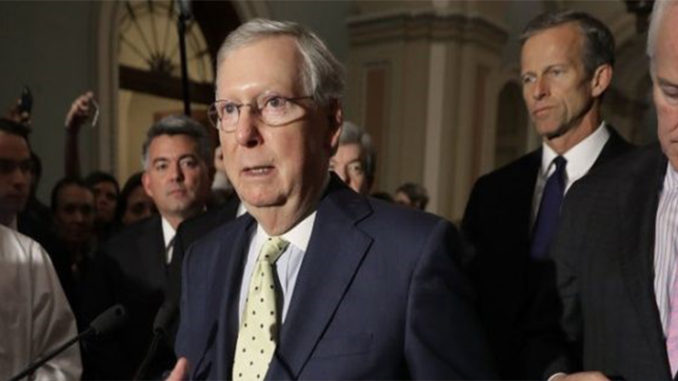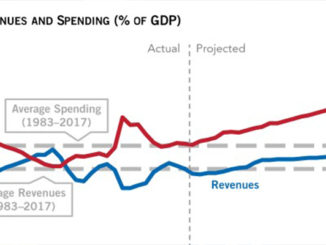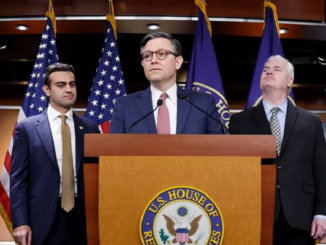
by Maria Barry-Jester
Senate Republicans released the text of their bill to repeal and replace the Affordable Care Act today, and like the House bill before it, the measure would give big tax cuts to the wealthiest Americans and roll back Medicaid, the health insurance program for the poor. It also would get rid of the unpopular mandate that most people have insurance or pay a fine.
The draft bill, called the Better Care Reconciliation Act, would repeal most taxes in the Affordable Care Act, including two on the wealthiest individuals, a medical device tax, a tax on tanning salons and a tax on the insurance industry. It would also restrict Medicaid reimbursements to Planned Parenthood clinics for a year.
The measure also includes a host of details that would affect how millions of Americans get their health insurance, how much they pay for it and what it covers. The measure would cut back subsidies that help defray the cost of insurance for people who don’t get it from their employer or a public program. And it would loosen regulations on the insurance markets, likely meaning lower premiums but for more limited health insurance coverage.
But how much this bill would affect a person largely depends on how she gets her insurance. The 142-page bill is complex, and it will take some time to fully understand what it would mean for the health care landscape. Still, there are some clear initial takeaways for different groups:1
The 20 percent2 of the population with Medicaid:
Much like the House bill, the Senate bill would make dramatic cuts to the health insurance program for people with low incomes. The ACA expanded Medicaid to cover everyone earning less than 138 percent of the federal poverty line, but the Supreme Court ruled that states could choose whether to participate in that expansion. The new measure would reduce how much the federal government pays for the program starting in 2021. For at least eight states, that means the expansion would end altogether — these states expanded Medicaid with the caveat that the expansion would end if its federal funding decreased, which would occur under the Senate bill. But the bill would go beyond just phasing out expansion, additionally enacting deep financial cuts to the part of Medicaid that covers children, pregnant women, people with disabilities and older people in nursing homes. That part of the program would be put on a strict budget, with limits to how much the federal government would contribute for care.
That’s very different from how the program works now. The federal government generally reimburses states for a percentage of whatever they spend on program enrollees. Medicaid expenses fluctuate broadly from year to year within states. Sometimes that’s related to outbreaks or the availability of a new, expensive drug, as was the case with costly pharmaceuticals used to treat Hepatitis C.
The cuts, which are even steeper than those in the bill that passed the House in May, essentially shift more of the cost of Medicaid back to states. States, in turn, are likely to react in a variety of ways. Some could look for the money to pay for enrollees, but the expense would be substantial. Others will likely limit eligibility or the care that is covered. Some could eliminate the expansion program altogether.
The bill does fix one problem with the ACA that arose after the Supreme Court ruling on Medicaid expansion. About 2.6 million people in 19 states that didn’t expand Medicaid landed in a health insurance gap: They earned too little to be eligible for subsidies (the ACA assumed everyone with incomes below the federal poverty line would be on Medicaid, so they weren’t eligible for subsidies), but they earned too much to qualify for Medicaid. These people would be eligible for subsidies under the Senate bill. They would have to spend about 2 percent of their already small incomes on premiums, however.
The 7 percent who buy private insurance:
Even though the Medicaid expansion affected more people, this is the group that has been at the center of much of the Obamacare discussion and criticism: It includes the people buying insurance on the marketplaces created by the ACA. The Senate bill would change how subsidies are provided to help some in this group buy insurance, and it would change what kind of coverage insurance companies have to offer.
For starters, insurance companies would have to pay a smaller portion of an enrollee’s costs each year than they currently do. That probably means that the insurance plans eligible for subsidies would have higher co-pays and higher deductibles.
But the bill also would change how the subsidies are calculated. Under the Senate plan, subsidies are tied to income and cost (if you make less and live in a place with expensive coverage, you get a larger subsidy), as is the case with the ACA. But they would apply only to people making up to 350 percent of the federal poverty line, about $42,000 this year; the cutoff under the ACA is 400 percent. And the bill would raise the amount that some people are expected to contribute to their insurance. A 60-year-old earning about $24,120 a year (about 200 percent of the federal poverty line) is currently expected to pay about $1,550 in premiums. Under the Senate bill, that would be $2,412. A 30-year-old earning that amount, however, would be expected to pay slightly less, about $1,400 under the Senate bill, compared with $1,550 under current law.
The cost of insurance would likely decrease under the Senate bill, meaning lower premiums. That’s because insurers would be allowed to sell plans that cover a smaller percentage of annual costs and fewer services. But removing the requirement that people get insurance will likely mean fewer healthy people signing up for plans, which would be worse for premiums.
A common complaint about Obamacare was that it hurt the middle class. It’s true that the middle class didn’t turn out to sign up for insurance under the ACA marketplaces the way lower-income people who received a lot of subsidies did. The Senate GOP bill could exacerbate that problem because it would further restrict who can get subsidies. People who don’t want insurance would no longer be required to either buy it or pay a tax, but it’s not clear that this legislation would make it easier for them to afford insurance if they wanted it.
The 49 percent who get insurance through their employer:
Employers will no longer be required to offer health insurance, which could affect people who are insured through their employers. But the Senate bill also keeps a tax that’s generally loved by economists and unpopular with the public: the “Cadillac tax.” Currently, people with employer-sponsored insurance get a tax break on money they spend on their coverage. The Cadillac tax essentially would cap that tax break, charging a 40 percent tax on insurance premiums paid beyond a cutoff (the tax wouldn’t start until 2020, but it would affect plans costing more than $10,200 in 2018 dollars).
There’s debate among experts over whether employers will adapt their plans to prevent employees from having to pay that tax, likely by raising deductibles, or will find creative ways to reduce health care costs so the plans don’t cost so much.
The 9 percent who are uninsured:
The fate of this group is the question looming over the Senate as it prepares for a report from the Congressional Budget Office, which will assess the bill’s impact. As with the House bill, the number of uninsured will likely be projected to grow under the Senate bill. Some could join the ranks of the uninsured by choice if the individual requirement to buy insurance were to go away. But others would be priced out of the market. A pending report from the CBO, due by early next week, will help clarify who might be uninsured under the Senate bill. But there would likely be an increase among at least three groups: 1. low-income people who currently qualify for Medicaid but would be cut from the program, 2. older adults, because insurers would be allowed to charge them higher premiums under the Senate bill than they can under current law, and 3. young and healthy adults who might have less incentive to buy insurance in the absence of the individual mandate. It would likely also include a swath of middle-income adults who are already uninsured, those who receive little in the way of help to buy insurance but still face relatively high premiums.
The country as a whole:
There would be “winners” and “losers,” as there are with every health care policy. The details matter, and policy wonks will surely begin to shake out their effects on the insurance market over the next few days. But the main outcomes are clear. The wealthiest people would get a large tax cut. The poorest would be the most likely to lose their insurance. The cost of insurance would go down for some, particularly younger adults. For middle-income, older adults who aren’t yet eligible for Medicare, premiums would go up. But, as with the ACA, the bill would do little to curb overall spending on health insurance, which means someone will be stuck with the bill. The Affordable Care Act was a redistribution of wealth that took money from the highest earners and used it to pay for coverage for the poorest. The government also foots a larger share of the bill. Under the GOP Senate bill, many of those costs would revert to individuals with low incomes.
Anna Maria Barry-Jester reports on public health, food and culture for FiveThirtyEight. @annabarryjester



